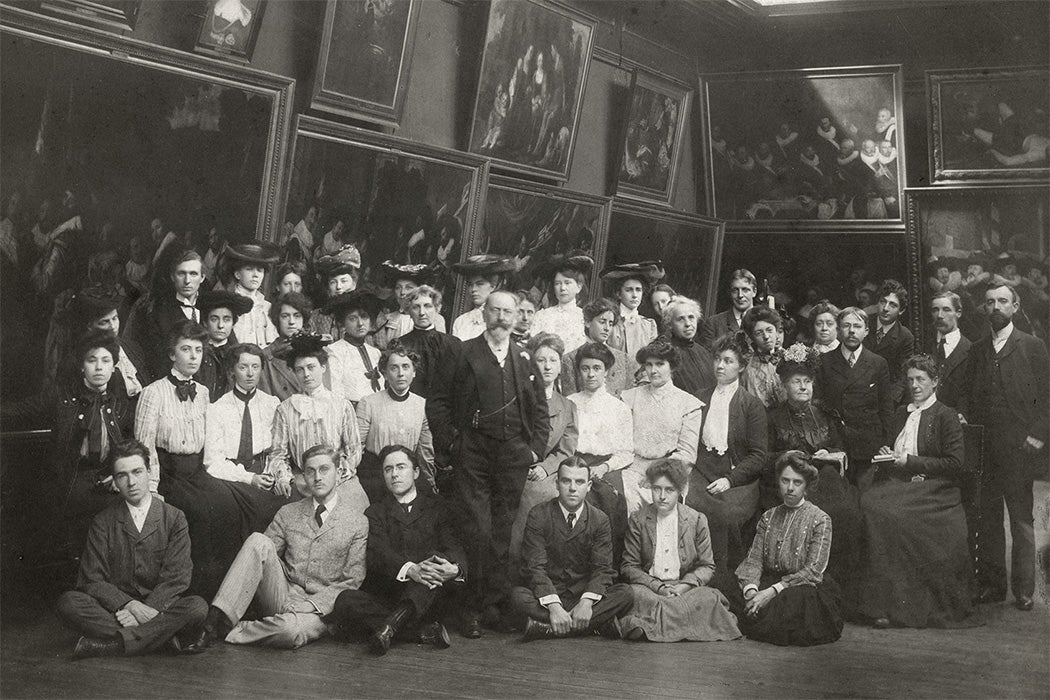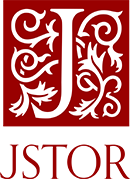The story of the establishment of the Chase School of Art, forerunner of the Parsons School of Design in New York, offers an unlikely object lesson in what happens when you seek to realize your creative aspirations in an era of political and cultural upheaval. In 1896, the Impressionist painter William Merritt Chase was ready to declare independence from the rigid hierarchies of the New York art scene and its dependence on European masters and methods. He dreamed of establishing what he considered an explicitly American school of art, one that encouraged artists to embrace and portray the unique character and energy of the young nation and its people, and he needed money. To get it, he founded an experimental new school for painting in Manhattan that would, ironically, thrive on the burgeoning hopes of women in an era of their growing liberty and opportunity.
Best remembered for society portraits, plein air paintings, pastel seascapes, dead fish still lifes, and depictions of dancing white clouds, Chase suddenly found himself in an unfamiliar role: he was, if not quite an equal rights leader, then an ambitious artist who, in pursuing his own interests, opened avenues for women artists and played a part in establishing a new era of American art beyond his own envisioning.
As June L. Ness writes in Archives of the American Art Journal, Chase stood among the most influential artists and art teachers in the country at the turn of the twentieth century. He was on the faculty at the Art Students League, the Brooklyn Art Association, and the Pennsylvania Academy of the Fine Arts; he instructed a cadre of private students in his home studios and abroad; he lectured in Connecticut, Chicago, and elsewhere; and he oversaw a summer art school outside the Long Island town of Southampton.
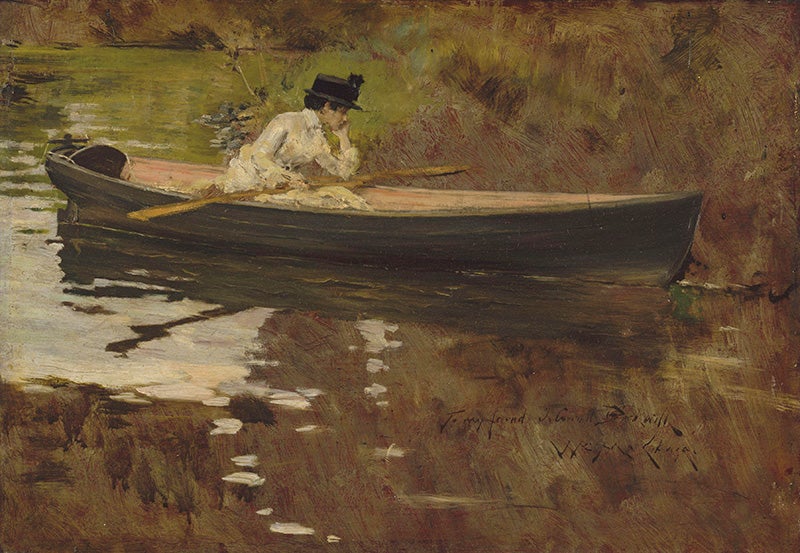
A man of his times, Chase and his wife, Alice Gerson, an amateur photographer, ran at the limits of their finances. In 1896, as parents to four children, they faced a turning point. Chase wanted to quit teaching altogether and devote himself to painting. Yet the couple also wanted to maintain luxury residences in both the city and the country while traveling extensively but lacked the resources to sustain such a lifestyle.
Weekly Newsletter
Chase then saw opportunity emerge from an unexpected source. In the late nineteenth century, middle-class white women were pouring into New York City from across the country to take advantage of the increasing number of professional opportunities in journalism, medicine, business, civic work, law, and the arts. The “New Woman,” a term coined in 1894, did as she liked, writes historian Ruby Maloni. She rode a bicycle. She went to college and attended the theater without a chaperone. She rejected tight-laced corsets, took an apartment with roommates, and ate out in restaurants. She joined clubs, pursued a career, and put off marriage, sometimes forgoing it entirely. Such New Women also enrolled in art schools by the thousands.
Chase’s school—unaffiliated with any college or museum, with relaxed admission standards that allowed acceptance of as many students, men and women, as possible—could provide the income he and Gerson needed. So it was that in the fall of 1896, Chase and a group of his more progressive students declared the methods of the Art Students League passé and seceded. A few weeks later, they opened the Chase School, offering classes in drawing and painting from life, composition, still life, and portraiture, in a series of makeshift classrooms near the famed “Ladies’ Mile District” on 23rd Street in Manhattan.
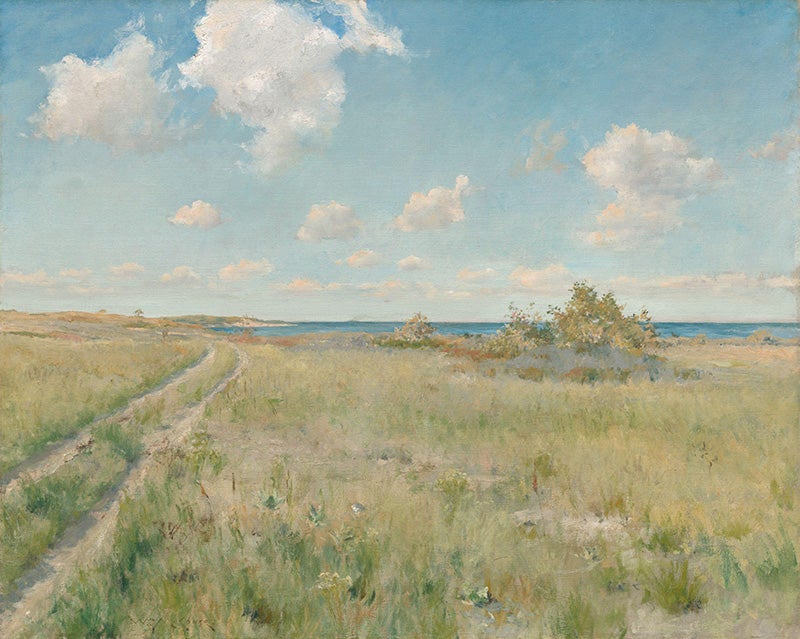
Although Chase originally planned to teach all the courses himself, he soon realized he needed help. He hired additional instructors who also sought to create art that would express an eclectic American spirit. Among them were three women who had been his students: Ami Mali Hicks, Alice M. Simpson, and Louise Lyons Heustis.
Chase set the tone for the new school in an inaugural address on October 5, 1896, telling students “I recognize no sex in art.” He asserted that “[w]omen should have an equal chance to develop their tastes” and vowed that he would “make no difference whatsoever in my instructions than if they were men.”
Contrary to the more restrictive League, the Chase School emulated the ecumenical approach to individual artistic style and liberal policies of the free-spirited Académie Julian in Paris, which prioritized instruction in a studio-based apprenticeship under the guidance of a master artist.
Chase established an open-door policy to maximize enrollment, requiring no strict prerequisites for admission; beginners worked alongside more advanced peers. He set tuition to compete with the League—eight dollars per class per month or a hundred a year to enroll full time—and determined that his school wouldn’t be governed by a board of control to avoid the kinds of conservative pressures he found so oppressive at the League.
The venture was an immediate success. First-time students enrolled by the dozens, as did some of the League’s best pupils. Chase won acclaim as a debonair and inspiring instructor, known for a generous and unconventional approach in the classroom. He used his celebrity status to place glowing reports of his students’ achievements in newspaper and magazine articles. Painter Lawton Parker, one of Chase’s favorite students and an original defector from the League, opined that the Chase School had “the strongest line of students ever brought together in New York.”
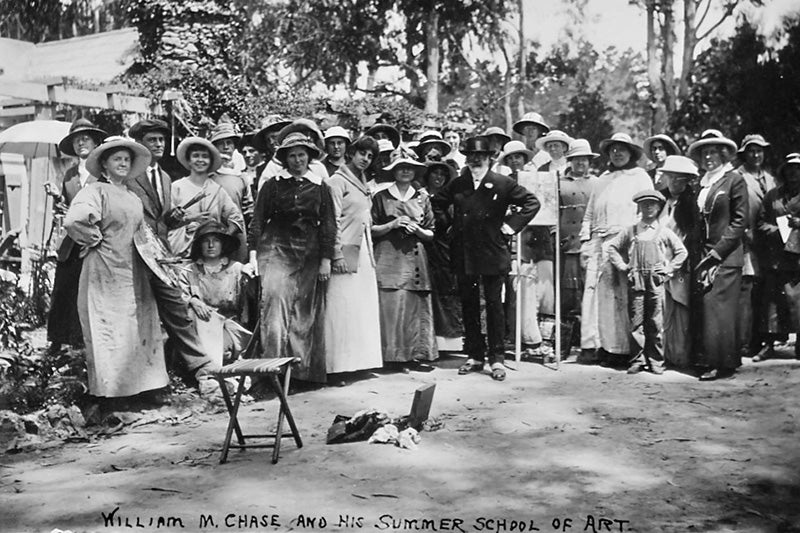
The school sponsored scholarships, mounted student exhibitions, expanded the curriculum, and added amenities and conveniences, including a gymnasium, painting demonstrations, and evening classes to attract more students. As researchers Cynthia V. A. Schaffner and Lori Zabar explain, like his art school in the bucolic Shinnecock Hills of eastern Long Island, which Chase established and directed for twelve summers starting in 1891, his Manhattan school also provided occasions for students to socialize outside of class; it organized dances, dinners, studio tours, and museum talks. The school made a splash in the press, and the money rolled in.
While Chase’s biographers praise him for his nuanced and loving portrayals of his wife and children, they don’t tell us if Chase’s commitment to providing equal instruction and opportunity to women was inspired by his partnership with Gerson and/or his devotion to his six daughters. They don’t indicate whether his egalitarian impulse was motivated by his students’ talent or perhaps the influence of one of his rumored mistresses. It’s plausible that he was motivated by a combination of sympathy for and belief in the women around him, as much as by financial gain. Whatever his reasons, Chase’s declaration in opening the school set the art world spinning and helped set the stage for women artists to demand equal opportunities.
Although often sent by their families to art school for so-called “finishing” classes, women at the Chase School did serious work. They enrolled in all the studio courses offered as well as in the classes which trained them to become art teachers themselves.
In the late nineteenth century, it was still quite difficult for women artists in the United States and in Europe to access nude models. Just as at the League, however, Chase’s school offered life classes in which students, segregated by sex, had access to both male and female nudes. Chase shrugged off the tradition embraced by the League of compelling students to begin painting using antique objects as models. Instead, he assigned students immediately into life classes with professional models. In this way, and in the general ethos of the school, Chase was aligned with some of the female-run art schools operating at the same time in England. As art historian Maria Quirk points out, like the Chase School, several British schools rebelled against the highly-standardized, traditional system of art education and adopted the atelier-style which “fostered creative individualism.”

More than one writer has called these women dilettantes, yet historian Betsy Fahlman challenges that characterization, noting that at the time “the very act of seeking art training was an act of modernity.”
Take the case of Louise Lyons Heustis, for instance, a Chase protégé and debutante from Mobile, Alabama, who moved to New York with the writer Rosalie Jonas in 1892, after three years at the Académie Julian. She spent summers painting at Shinnecock and was closely affiliated with a group of professional women, several of whom were also Chase students, sharing quarters in the historic Windermere Apartments. In 1896, Huestis’s career took off as her commercial illustrations began appearing in prominent magazines and, along with her colleague Ami Mali Hicks, winning accolades.
More to Explore
18th-Century Lovers Exchanged Portraits of Their Eyes
While many of the male students supported the women in their classes on an individual basis, tensions between them churned more generally. The men in the Chase School worried lest their bohemian enclave devolve into a charm school for well-bred young ladies destined to return to their hometowns.
Indeed, one of the reasons some men left the League was their perception that the institution treated women too preciously and that the school administration labored to cultivate a puritanical atmosphere in a place that was by nature loose and raucous. The more libertine Chase School encouraged originality and deep engagement with the work from its male and female pupils. Chase exhorted students to “cultivate individuality,” according to a 1904 Washington Post story, and emotionally interpret—not merely copy—the scenes they depicted. He advised students to develop their own personal style and to flout conventional wisdom. Dozens of female students took his advice and carried their rebellions beyond the realm of art and into that of politics.
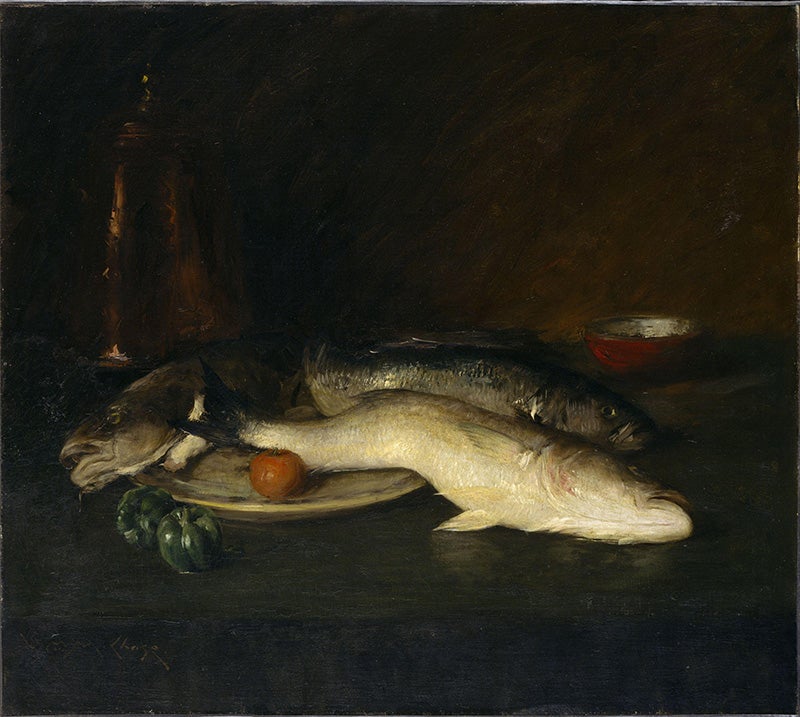
As word of the Chase School and its philosophy spread, more and more students enrolled. By the end of its first year, there were 120 matriculating, and by the start of the second, in September 1897, Chase moved the program to better accommodations at West 57th Street, which boasted larger capacity for day and evening classes.
There, he continued to urge his pupils to reject the confines of tradition. He wasn’t naive enough to believe everyone who studied with him would become a professional artist. Recognizing the too-often insurmountable obstacles facing his women students, he worried especially when they seemed reluctant to assert their artistic independence. The Chase School, he hoped, would help his students, and especially the women, develop the tools that would allow them to overcome societal impediments and make their voices heard on any number of concerns.
Some of them did. In 1898, forty women students reportedly signed a telegram to President William McKinley. “To hell with diplomacy!” they are said to have declared, tersely expressing their anger at the administration’s delay in declaring war on Spain.
Outraged, John Griggs, Attorney General of the United States, along with a member of the socially prominent Van Rensselaer family, withdrew their daughters from the school. Chase tried to tamp the flames by denying the telegram was sent, but to little avail. Female students painted American flags on the studio walls in protest. They burst out singing the “Star Spangled Banner” and other patriotic songs in the middle of class.
Overwhelmed by the outspokenness he had fostered among female students, Chase announced his intention to expel students for their outburst. The following day, the husband of one protestor demanded Chase apologize for threatening his wife. Finding contrition less than forthcoming, the husband hauled off and punched Chase, causing chaos in the school halls, according to a story in the Philadelphia Times. Police arrived, and the press had a field day with months-long roiling drama.
To distance himself and his school from the controversy, Chase changed the institution’s name to the New York School of Art. He also turned over its leadership, installing Lawton Parker as president. Parker attempted to stabilize the situation, but the school continued to be plagued by controversy and his tenure was short-lived.
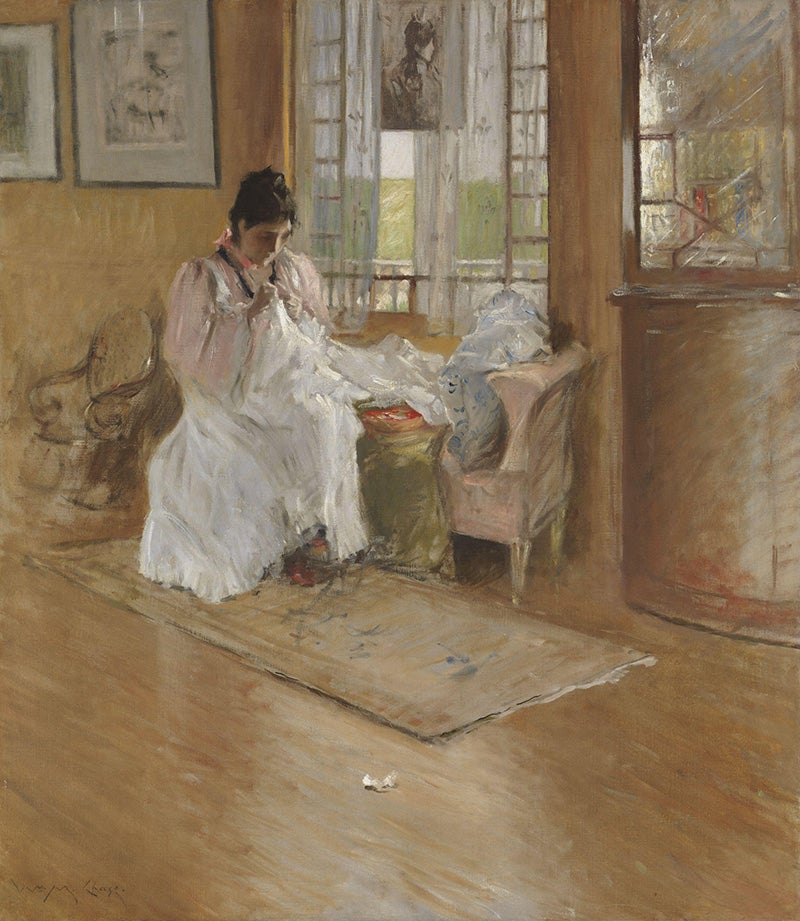
In 1902, painter Robert Henri joined the faculty. Although Chase admired Henri’s work, he and the younger man, who was also a dynamic and popular teacher, did not get along. While they both embraced the bravura manner of painting, Chase was devoted to craftsmanship and suitably attractive subjects, while Henri encouraged his students to paint the less seemly sides of urban life. Henri thought Chase old-fashioned and a dandy, and publicly denounced Impressionism as academic and sentimental. Chase despised Henri’s lack of decorum and disdain for technique, deeming his work “gruesome.”
Tensions rose as Henri’s style and influence on the school took hold. A break seemed inevitable. Following a highly-publicized conflict over Modernism in 1907—Chase preached “art for art’s sake” while Henri avowed his belief in “art for life’s sake”—a majority of the students renounced the principals espoused by the founder. Chase resigned in indignation and took refuge at the League.
There, Chase redoubled his commitment to expanding equality for women. In 1910, he joined the actress Billie Burke in staging a benefit for the Art Workers’ Club, a progressive women’s union started a decade earlier by artists and models.
Not only had the Chase School created a supportive environment for women to pursue unconventional careers, it had also provided them with the space to share political information and to organize. As the suffrage movement grew, women painters took up banners alongside sculptors, models, writers, musicians, teachers, doctors, dancers, college women, and thousands of others, with many Chase students among them.
Ami Mali Hicks, who also worked as art director of the Lotus Press while at the Chase school, later became a member of the secret feminist debate society, Heterodoxy, and served as treasurer of a women’s political activist group. In 1915, she explained the correlation of her artistic and political convictions this way to the Atlantic City Gazette-Review: “I am an artist and no real art can exist where joy and freedom are strangers. I do not hope to make earth into a heaven, but I do hope that we can eradicate some portion of our earthly hell.”
That same year, another contingent of Chase School students—including Heustis, Hicks, Ethel Myers, and Alice Schille—took part in a historic art show to raise funds for the suffrage campaign in advance of a referendum on the matter in New York.
For his part, Chase continued to work until his health failed, insisting “the great record of America must come from Americans themselves.” He died in 1916, but his legacy endured in the women whom he implored to think for themselves.
The Chase School was not alone in shaping women artists as workers and citizens, but it was a central mover in that stream of change. Not only did its alumni organize and campaign for woman suffrage, many, like Alice Simpson, joined in the war effort—raising funds, building military housing, and driving ambulances on the front. Dozens more returned to their hometowns where they implemented Chase’s pedagogy in conducting art classes of their own.
While Chase is rightly remembered as a leading spirit in the “Renaissance of American art,” as he was called in American Art News, he left another, less recognized, legacy. In striving to carve out a distinctly American art movement, he helped democratize American art by fomenting a network of hundreds of socially and politically committed women artists, who, fittingly, both fulfilled and outran Chase’s own ambitions.
Support JSTOR Daily! Join our membership program on Patreon today.
